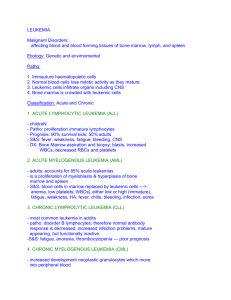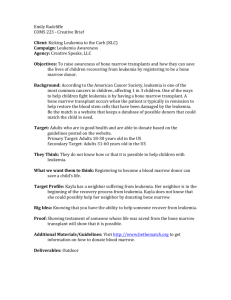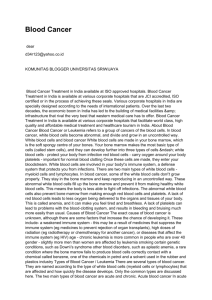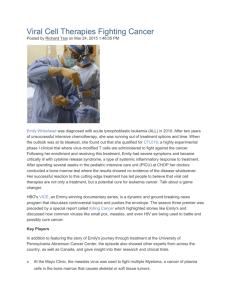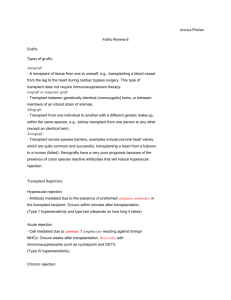Adult Acute Myeloid Leukemia:
advertisement
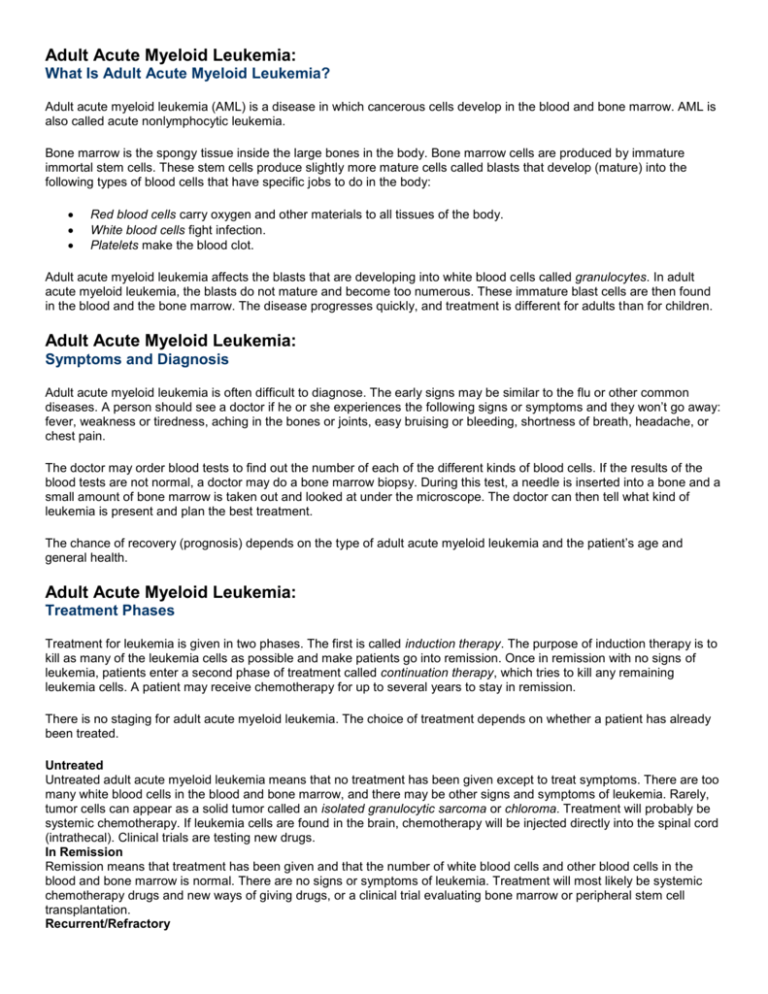
Adult Acute Myeloid Leukemia: What Is Adult Acute Myeloid Leukemia? Adult acute myeloid leukemia (AML) is a disease in which cancerous cells develop in the blood and bone marrow. AML is also called acute nonlymphocytic leukemia. Bone marrow is the spongy tissue inside the large bones in the body. Bone marrow cells are produced by immature immortal stem cells. These stem cells produce slightly more mature cells called blasts that develop (mature) into the following types of blood cells that have specific jobs to do in the body: Red blood cells carry oxygen and other materials to all tissues of the body. White blood cells fight infection. Platelets make the blood clot. Adult acute myeloid leukemia affects the blasts that are developing into white blood cells called granulocytes. In adult acute myeloid leukemia, the blasts do not mature and become too numerous. These immature blast cells are then found in the blood and the bone marrow. The disease progresses quickly, and treatment is different for adults than for children. Adult Acute Myeloid Leukemia: Symptoms and Diagnosis Adult acute myeloid leukemia is often difficult to diagnose. The early signs may be similar to the flu or other common diseases. A person should see a doctor if he or she experiences the following signs or symptoms and they won’t go away: fever, weakness or tiredness, aching in the bones or joints, easy bruising or bleeding, shortness of breath, headache, or chest pain. The doctor may order blood tests to find out the number of each of the different kinds of blood cells. If the results of the blood tests are not normal, a doctor may do a bone marrow biopsy. During this test, a needle is inserted into a bone and a small amount of bone marrow is taken out and looked at under the microscope. The doctor can then tell what kind of leukemia is present and plan the best treatment. The chance of recovery (prognosis) depends on the type of adult acute myeloid leukemia and the patient’s age and general health. Adult Acute Myeloid Leukemia: Treatment Phases Treatment for leukemia is given in two phases. The first is called induction therapy. The purpose of induction therapy is to kill as many of the leukemia cells as possible and make patients go into remission. Once in remission with no signs of leukemia, patients enter a second phase of treatment called continuation therapy, which tries to kill any remaining leukemia cells. A patient may receive chemotherapy for up to several years to stay in remission. There is no staging for adult acute myeloid leukemia. The choice of treatment depends on whether a patient has already been treated. Untreated Untreated adult acute myeloid leukemia means that no treatment has been given except to treat symptoms. There are too many white blood cells in the blood and bone marrow, and there may be other signs and symptoms of leukemia. Rarely, tumor cells can appear as a solid tumor called an isolated granulocytic sarcoma or chloroma. Treatment will probably be systemic chemotherapy. If leukemia cells are found in the brain, chemotherapy will be injected directly into the spinal cord (intrathecal). Clinical trials are testing new drugs. In Remission Remission means that treatment has been given and that the number of white blood cells and other blood cells in the blood and bone marrow is normal. There are no signs or symptoms of leukemia. Treatment will most likely be systemic chemotherapy drugs and new ways of giving drugs, or a clinical trial evaluating bone marrow or peripheral stem cell transplantation. Recurrent/Refractory Recurrent disease means that the leukemia has come back after going into remission. Refractory disease means that the leukemia has failed to go into remission following treatment. Radiation therapy may be given to reduce symptoms. Patients may also choose to take part in clinical trials of new chemotherapy drugs or bone marrow transplantation. If the leukemia cells have spread to the brain, radiation therapy to the brain or intrathecal chemotherapy will be given. Adult Acute Myeloid Leukemia: Treatment Options The main treatments for adult acute myeloid leukemia are described below along with common side effects. Side effects can occur with cancer treatments because healthy cells are often damaged along with cancer cells. The type and extent of these side effects vary depending on the particular treatment involved, its duration, and its dose. Chemotherapy Chemotherapy is the use of drugs to kill cancer cells. Some anticancer drugs are injected into a vein (IV) or muscle; some are given by mouth; some are injected into the skin. Chemotherapy is a systemic treatment, meaning that the drugs flow through the bloodstream to nearly every part of the body to kill cancerous cells. Chemotherapy may sometimes be put into the fluid that surrounds the brain by inserting a needle into the brain or back (intrathecal chemotherapy). It is generally given in cycles: a treatment period is followed by a recovery period, then another treatment period, and so on. Chemotherapy drugs generally target rapidly dividing cancer cells. However, other cells that also divide rapidly include blood cells, cells that line the digestive tract, and cells in hair follicles. Unfortunately, these healthy cells may also be impacted by the chemotherapy drugs, resulting in side effects such as infections, tiredness, temporary hair loss, mouth sores, and other symptoms. Not all chemotherapy patients develop all of these symptoms, and they usually go away during the recovery period or after treatment stops. Medicines and other treatments are available to control or minimize many of these symptoms. Radiation Therapy Radiation therapy is the use of high-energy x-rays to kill cancer cells and shrink tumors. Radiation for adult acute myeloid leukemia usually comes from a machine outside the body (external radiation therapy). The most common side effects of radiation therapy are tiredness, skin reactions in the treated areas (such as a rash or redness), and loss of appetite. Radiation therapy may also cause a decrease in the number of white blood cells that help protect the body against infection. Most of these side effects can be treated or controlled and in most cases they are not permanent. Stem Cell Transplantation Stem cell transplantation is a treatment in which a patient’s diseased bone marrow is replaced with healthy stem cells to repopulate the marrow. Allogeneic transplant: A transplant using marrow from a relative or person not related to the patient is called an allogeneic transplant. Allogeneic transplants may be done using either a standard high-dose therapy or a less toxic, nonablative, immunosuppressive therapy. · · In the standard high-dose therapy approach, all of the bone marrow in the body is destroyed with high doses of chemotherapy with or without radiation therapy. Healthy marrow or blood stem cells are then taken from another person (a donor) whose tissue is the same or almost the same as that of the patient. The donor may be a twin (the best match), a brother or sister, or a person who is not related. The healthy stem cells from the donor are then transferred to the patient through a needle in the vein, and the new marrow replaces the original marrow that was destroyed. In a nonmyeloablative transplant, the goal is not to destroy the patient’s marrow but to allow for the donor cells to take hold or “engraft.” In this type of transplant, less intensive medications are used and the marrow is not completely destroyed prior to the transplant. Autologous transplants: Another type of bone marrow transplant, called an autologous bone marrow transplant, is being studied in clinical trials. In this type of transplant, blood stem cells are taken from the patient after treatment with drugs to kill cancer cells. The stem cells that were taken from the patient are then frozen and stored. Next, high-dose chemotherapy is given to the patient with or without radiation therapy to destroy the remaining leukemia cells. The frozen stem cells are then thawed and given back to the patient through a needle in a vein to repopulate the marrow and make blood cells. Another type of autologous transplant is called a peripheral blood stem cell transplant. The patient’s blood is passed through a machine that removes the stem cells (immature cells from which all blood cells develop) and then returns the blood to the patient. This procedure is called leukapheresis and usually takes 3 or 4 hours to complete. The stem cells are treated with drugs to kill any cancer cells and then frozen until they are transplanted to the patient. This procedure may be done alone or with an autologous bone marrow transplant. A greater chance for recovery occurs in hospitals that do more than five stem cell transplantations a year. Biological Therapy Biological therapy tries to get the body to fight cancer. It uses materials made by the patient’s body or made in a laboratory to boost, direct, or restore the body’s natural defenses against disease. Biological therapy is sometimes called biological response modifier (BRM) therapy or immunotherapy. Monoclonal antibodies are sometimes used in treating adult acute myeloid leukemia. Adult Acute Myeloid Leukemia: Clinical Trials Another treatment option available to some patients is to participate in a study of a new cancer treatment. Every successful cancer treatment being used today was first tested in a clinical trial, a three-step research process designed to evaluate the safety and effectiveness of new treatments for diseases. Clinical trials are conducted at the end of a much longer process of developing and testing new therapies in the laboratory. Patients who participate in successful trials are the first to benefit from the new therapy. Doctors in many hospitals and cancer centers across the country conduct clinical trials as new drugs and other therapies become available for treating cancer patients. Each carefully planned study is designed to answer certain questions and to find out specific information about how well a new drug or treatment method works. All new treatments must go through three steps or phases of clinical trials: Phase I trials: These first studies in people evaluate how a new drug should be given (by mouth, injected into the blood, or injected into the muscle), how often, and in what dose. A Phase I trial usually involves only a small number of patients, sometimes as few as a dozen. Phase II trials: A Phase II trial continues to test the safety of the drug and begins to evaluate how well the new drug works. Phase II studies usually focus on a particular type of cancer. Phase III trials: These studies test a new drug, a new combination of drugs, or a new surgical procedure in comparison to the current standard for treatment. A participant will usually be assigned to the standard treatment group or the new treatment group at random (called randomization). Phase III trials often enroll large numbers of people and may be conducted at many doctors' offices, clinics, and cancer centers nationwide. All clinical trial participants receive the best care possible, and their reactions to the treatment are watched very closely. If the treatment does not seem to be helping, a doctor can take a patient out of a study. A patient may choose to leave a trial at any time. If a patient leaves a research study for any reason, standard care and treatment are still available.
